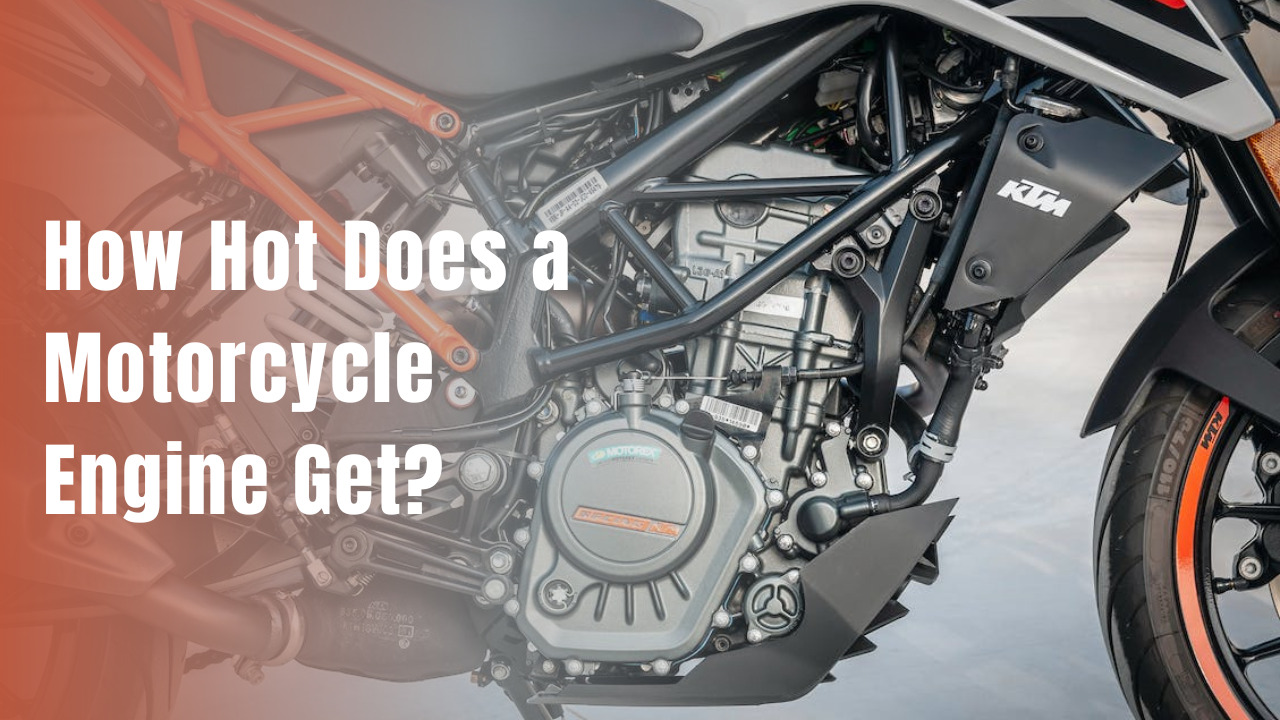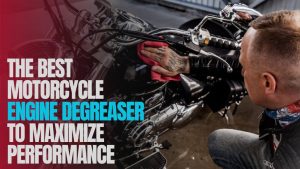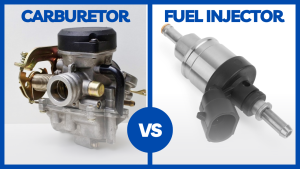Keeping your motorcycle engine running smoothly takes some know-how. How hot does a motorcycle engine get? It pays to understand how heat affects your ride.
We’ll break down what “normal” temperatures mean for different bikes, what can cause an engine to overheat, and most importantly, how you can keep yours running cool. From ambient temperatures to fluid levels, we’ll cover all the factors that influence heat so you can keep your engine performing at its best.
KEY POINTS
- Normal temp range is 150-220°F, but can vary by 5-10°F
- Liquid cooling best, air cooling varies most
- Signs of overheating include steam, knocking
- Common causes are low fluid levels, worn parts
- Monitor temps, fill fluids, inspect regularly
- At 230°F+ pull over, let it cool completely
- Riding style, weather, and altitude affect temps
- Regular maintenance prevents overheating issues
What’s Considered a “Normal” Temperature for Your Bike’s Engine?
How hot does a motorcycle engine get? Most folks would agree that a standard operating temperature for a motorcycle engine is between 150 to 220 degrees Fahrenheit. That’s usually the happy zone where everything is running smoothly.
But it’s good to know that range can budge up or down a bit depending on your specific ride. The make and model play a part – you’ll often see sports bikes tend to run hotter since they’re designed for power. Even factors like what the weather’s doing or your preferred riding speed can swing things one way or another.
Don’t fret too much if your gauge dips below 150°F on a frosty morning. As long as it creeps up to that normal range once you get moving, all should be well. Similarly, if a heat wave has you topping out at 220°F, that’s perfectly normal too.
Where you really want to keep an eye out is if things breach 250°F. That’s when it’s time to find a shady spot and let ‘er cool off. The engine will start to feel the strain if it hangs out above that temperature for too long. Before you know it, you could be dealing with some pricey repairs.
So, 150-220°F/65-105°C is the typical happy place. But give or take a bit based on the bike, conditions, and your right-hand throttle finger. Just monitor that gauge and avoid any lengthy stints over 250°F to keep your engine happy and healthy.
Factors That Fluctuate Motorcycle Engine Heat
When it comes to keeping your engine running at an optimal temperature, not all cooling systems were created equal. There are a few main types out there, and each handles heat dissipation a bit differently.
a. Cooling System Type
First up, you’ve got air cooling, which relies totally on atmospheric airflow through cooling fins to draw heat away. It’s a simpler setup without liquids involved, but not quite as effective as other methods. Next is oil cooling, where engine oil circulates through channels to absorb heat. A step up from air, but still not a totally sealed system.
Finally, liquid cooling uses its own dedicated coolant loop to actively pull heat from the engine and transfer it to a radiator. Much more capable than the other two at transferring massive amounts of heat quickly and efficiently. Pretty obvious which performs best just from the descriptions, right?
b. Ambient Temperature
Something else that affects temperatures is plain old Mother Nature. Especially with air-cooled engines, hot summer temps mean those cooling fins have a tougher time doing their job when the air itself is already toasty.
The larger the difference between ambient air and engine heat, the better that convection current works. So don’t be surprised if your bike runs a tad hotter on 95-degree afternoons than 50-degree mornings.
c. Engine/Motorcycle Model
Beyond the engineering under the hood, your riding habits can cause temps to fluctuate too. The model you choose comes into play – a heavyweight cruiser puts less strain on components than a high-powered sportbike.
Those 600cc supersports may run hot sole because they’re built for speed. But even on more mild-mannered bikes, stop-and-go traffic means more spurs of acceleration that add cycle after cycle of extra workload.
d. Riding Conditions
Road quality is another factor. Going over potholes or riding on gravel forces the suspension to work overtime absorbing shocks. All that bumping and jerking gets transferred back to already taxed engine mounts too.
The condition of your fluids also matters a lot. Dirty oil can’t lubricate as efficiently, and low coolant leaves less margin for error. Both mean extra heat with no buffer.
Whether taking a Sunday spin or daily commuting, being conscious of how you ride makes a difference for engine temps. Go easy on hills or in dense traffic when things feel warm already. A little more tender loving care can go a long way for keeping your bike running cool.
SEE MORE: Motorcycle Jerks When Feathering the Clutch: What to Do?
Signs of Motorcycle Engine Overheating: When the Heat Gets too Hot!
Alright folks, it’s time to learn the telltale signs that your engine’s running a little too toasty.
First up, keep an eye on that gauge – if it’s cracking 230 degrees, that’s a no-go zone.
Next, listen for the pinging noises. Sounds like somebody popping popcorn in there? Yuk, that means things are getting crispy inside. You’ll also notice a loss of power or intermittent stalling. The engine’s too overwhelmed by the heat to run right.
And here’s a big one – watch out for that white steam rising! It may look cool, but it’s never a good idea to see it billowing from under your fairings or radiator caps. That haze means the coolant’s gone into overdrive trying to shed excess heat.
Finally, use your senses. Does the motorcycle feel like it’s losing power or stalling? If so, that extra insulation isn’t helping the situation. Time to pull over until everything cools down below that 230 degree mark.
Don’t let it get to this point in the first place. Stay on top of fluid levels and heed these danger signs so you can head ’em off before any costly damage happens. Your engine will thank you!
Overheating Causes: How Hot Does a Motorcycle Engine Get?
Alright, so we know the signs of an overheating engine – now let’s dive into some frequent culprits.
One of the biggest is low coolant. That lifeblood keeps the motor from getting too toasty, so check reserve levels regularly.
Contaminated coolant is just as bad news. Dirty fluids can’t circulate heat efficiently. Give it a change if it’s got an odd color or smell.
While we’re on fluids, worn engine parts are a steam builder too. Old seals letting oil seep into places it shouldn’t be, like the combustion chambers. Time for a rebuild or replacement there.
Moving right along, a busted radiator fan means hot air isn’t getting pushed through the rad like it should. No bueno for shedding degrees! Give that fan a check for noises or obstructed blades.
Rounding out some common causes, low oil is no fun either. That slicky stuff protects moving parts from friction, so without enough your engine works much harder than it needs to.
Ever notice a squeaking or grinding coming from the water pump? Its job is circulating coolant so I’d give it a suspicious side-eye if overheating occurs. Time for a test ride and stethoscope check!
Lean air/fuel mixtures are culprits too – not enough fuel for the amount of air means a hotter burn. Listen for pinging and check your carbs or fuel injectors.
Finally, don’t rule out a stubborn thermostat doing its job too well (or not at all!). It controls coolant flow so its failure to open/close means temperatures run amok.
Don’t Panic! Take These Actions During Engine Overheating
Alright, despite your best efforts it happens – you notice that temp gauge peeking into the red. Whatever you do, don’t keep riding! Even if you’re miles from home, pull over immediately.
A few more minutes at excessive heat could spell disaster. Once stopped, shut her down and remove that key. Pop the seat to check fluid levels too, just in case it’s a simple top off job.
Whatever you do, resist the urge to rev it until it’s fully cooled. Remember, awesome engine noises will still be there once she’s back in the sweet spot. Use this forced pause to take some deep breaths – no need to fret yet.
If levels all look normal, let her sit for at least 30. Zip up the vents if it’s sunny out to speed the process. Once cooled, try a gentle restart. If the issue persists, it’s time to call for backup.
So what you’ll do are:
- Turn off engine immediately and let cool completely
- Check for obvious problems like coolant or oil level
- Have bike serviced if issue can’t be identified
With a quick shut-down and some patience, you’ve saved yourself a lot of headache down the line. Cool heads prevail – don’t lose your cool when temperatures rise!
SEE MORE: How Much Engine Oil Is Too Much for a Motorcycle
Preventing Engine Overheating: Keep the Heat Away with Easy Checks
Thankfully there are simple things you can do to keep temps low.
- Monitor Fluid Levels
- Regular Inspections for Wear
- Drive Smoothly at Safe Speeds
- Change Coolant Per Schedule
First up, fluid levels – check them like it’s your job. Coolant, oil, you name it. Topping off takes 2 minutes but saves hours of headache down the road.
While you’ve got the seats up, do a quick inspection too. Look for wear and tear or leaks that could lead to trouble. Tighten what’s loose and make notes of what to address later.
Ride style matters too – we all wanna rip that throttle sometimes, but taking it easy in traffic or hauling heavy loads helps the engine stay happy and cool.
And never neglect maintenance. Stick to schedules for coolant flushes every couple years or as instructed. Fresh fluid transfers heat like a champ.
Small, regular checks are your best defense against overheating blues. Take 10 minutes a week for fluids, filters and a visual once-over. Your engine will thank you in the long run!
Final Words
We hope this breakdown of engine temps gave you some useful info to keep your ride running cool. How hot does a motorcycle engine get? The normal range is 150-220°F, but watch for signs like steam or pinging if it hits the high 230s.
Also, keep an eye on fluid levels, fan and pump function, and avoid baking your bike in traffic. With some regular maintenance love like we discussed, you’ll be preventing overheating issues before they even start. Ride safe out there and keep that gauge in the green zone!
FAQs: How Hot Does a Motorcycle Engine Get?
My bike’s temperature gauge shows up to 260°F on long highway rides. Is this OK?
Up to 250°F is the general limit, so 260°F is pushing it. Consider upgrading your bike’s cooling system to better dissipate heat.
How much does engine temperature affect horsepower and performance?
A hotter engine can gain a few horsepower as parts expand for better combustion. But past the ideal range it loses power through degradation. Stay within 150-220°F for best results.
My vintage bike runs hot – can I use a lower temperature thermostat?
On older air-cooled engines, a 190°F thermostat rather than 200/210°F may help. But avoid going too low or the engine won’t heat fully. Consult your manual.
What’s the ideal operating temp for different types of modern engines?
Liquid-cooled inline 4s and V-twins stay about 180-210°F. Oil/air-cooled flat twins 190-210°F. Sportbikes hotter at 200-220°F due to more aggressive tuning.
Can I install an auxiliary oil cooler/radiator for better temperature control?
Yes, adding a cooler is a common mod for reducing temps 5-10°F during extreme conditions without compromising oil/coolant flow. Just size it correctly for your bike.
How does altitude affect engine operating temperature?
At higher elevations with less air density, it’s normal for temps to run 5-10°F warmer due to weaker convection cooling. No cause for concern in that range.




